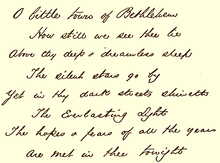|
O Little Town of Bethlehem
"O Little Town of Bethlehem" is a Christmas carol. Based on an 1868 text written by Phillips Brooks, the carol is popular on both sides of the Atlantic, but to different tunes: in the United States and Canada, to "St. Louis" by Brooks' collaborator, Lewis Redner; and in the United Kingdom and Ireland to "Forest Green", a tune collected by Ralph Vaughan Williams and first published in the 1906 English Hymnal. WordsO little town of Bethlehem
Phillips Brooks, Sunday School Service and Hymn Book (NY: E.P. Dutton, 1870).
The text was written by Phillips Brooks (1835–1893), an Episcopal priest, then rector of Church of the Holy Trinity, Philadelphia, and later of Trinity Church, Boston. He was inspired by visiting the village of Bethlehem in the Sanjak of Jerusalem in 1865. Three years later, he wrote the poem for his church, and his organist Lewis Redner (1831–1908) added the music. The text of the carol was first published in The Sunday School Service and Hymn Book, arranged by the Sunday School Committee of the Diocese of Ohio in five stanzas of eight lines. The original fourth verse is omitted in most hymn and carol books.[1] MusicSt. LouisRedner's tune, simply titled "St. Louis", is the tune used most often for this carol in the United States.[2] Redner recounted the story of his composition:[2]
 Forest GreenIn the United Kingdom and the Commonwealth, and sometimes in the U.S. (especially in the Episcopal Church), the English hymn tune "Forest Green" is used instead. "Forest Green" was adapted by Ralph Vaughan Williams from an English folk ballad called "The Ploughboy's Dream" which he had collected from a Mr. Garman of Forest Green, Surrey in 1903.[4][5] Henry Garman was born in 1830 in Sussex, and in the 1901 census was living in Ockley, Surrey; Vaughan Williams' manuscript notes he was a "labourer of Forest Green near Ockley – Surrey. ([aged] about 60?)",[4] although Mr Garman would have been nearer 73 when he recited the tune.[6] The tune has a strophic verse structure and is in the form A–A–B–A. Adapted into a hymn tune harmonised by Vaughan Williams, it was first published in the English Hymnal of 1906 (transcribed below).  Other versionsTwo versions also exist by Henry Walford Davies, called "Wengen", or "Christmas Carol".[7] "Wengen" was published in Hymns Ancient and Modern in 1922,[8] meanwhile "Christmas Carol" is usually performed only by choirs rather than as a congregational hymn. This is because the first two verses are for treble voices with organ accompaniment, with only the final verse as a chorale/refrain harmony. This setting includes a recitative from the Gospel of Luke at the beginning, and cuts verses 2 and 4 of the original 5-verse carol. This version is often performed at the service of Nine Lessons and Carols in King's College, Cambridge.[9] William Rhys-Herbert included a new hymn-tune and harmonization as part of his 1909 cantata, Bethany. The song has been included in many of the Christmas albums recorded by numerous singers in the modern era. "Little Town" is an arrangement of "O Little Town of Bethlehem" by English singer-songwriter Chris Eaton. It was first recorded and released by English singer Cliff Richard in 1982 who had a Christmas hit with it in the UK. In the US, the better known version is by American CCM artist Amy Grant, released on her 1983 Christmas album.[10] A new tune for O little Town of Bethlehem called "Enmore" by the composer Philip Trumble was first published in 1987 [11] Philip Trumble's was also published in the 2022 publication Christmas Praise [12][13] See alsoReferences
External linksWikisource has original text related to this article:
Wikimedia Commons has media related to O little town of Bethlehem.
|
||||||||||||||||||

